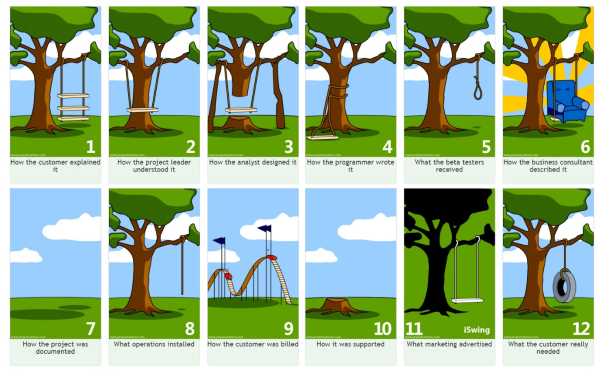A Golden Classic: Tree Swing Cartoons
Hanna (Hania) Kryszewska is a freelance teacher, teacher trainer, trainer of trainers and mentors, and former senior lecturer at the University of Gdańsk, Poland. She is a senior faculty trainer at Pilgrims TT, ELTTS trainer at University of Oxford and OTA trainer with OUP. She is an author of many ELT articles, resource books, course books, teacher training resources and online asynchronous TT courses for Orient BlackSwan. Since February 2006, she has been the editor of website Magazine Humanising Language Teaching. Email:hanka.kryszewska@pilgrimsteachertraining.eu
Introduction
This article will be short and sweet. I would like to revive one kind of material I have always enjoyed using when teaching in companies.
Stage 1
Theoretically, it is self explanatory. A picture and a caption. What else could you add?
What I do with it is the following. I just ask the businesspeople I teach to say what memories a picture or pictures bring to them.
And then memories flow and the speaking cannot be stopped. Enjoy.

Source: https://pmac-agpc.ca/project-management-tree-swing-story
Stage 2
The class work in pairs or in small group. Students discuss, their reactions to the 10 points.
- When a customer describes what s/he wants, it tends to be true that s/he always overstates it.
- The product owner gathers the customer's requirement and summaries it.
- Engineers follow PO's summary and make it work. Well, to some extent...
- Then programmers will write it. However, when you test it, it is not workable.
- Finally, we have a product, so the sales can start their job by exaggerating its features.
- When you want to check the document, it is always nowhere to be found.
- What the operations build is simply a rope. Gosh, I don't know what to say.
- Customers are billed for extraordinary experiences.
- The way Helpdesk solves problems is just simple and "radical".
- Voila! It turns out what the customer truly wants is just a simple tire swing.
Stage 3
Turn the text below into a cloze test. Tell the students to fill the gaps with one word only.
Communication: The Big "C"
A project is about a bunch of 1._______ people working together to 2.______ the requirements. The role of a project manager is to 3.______ details through strategic, efficient and meaningful 4._______ on a project. "About 90% of the time in a project is 5.______ on communication by the project manager". As it is known, communication is a very important 6._______ of any well-organized project. Therefore, project management is not just 7._____ and processes.
A project is usually done by several departments, which means cross-functional 8.__________ is required. The information 9.________ from one department to another is done by documents and meetings. Everyone should know what the other team 10._______ is doing. If one asked for a leave, others could do his work and know 11.________ where to start. The project could be 12._______, if the communication fails and no one knows what he has been doing and no one can 13._____ him.
The 12.________ is also emphasized in Scrum events. For example, the Daily Scrum. Daily Scrum is a time-boxed short 13._______ for about 15 minutes and 14.______ every morning with team members before they start to do the work for today. It aims to 15.______ what everyone of the project team is doing and 16.________what he plans to finish today. By doing Daily Scrum, it keeps every one of the team on the same 17.______.
Discuss the options and suggestions.
Variations
1 You can create your own close test by removing your own words from the text below.
2 With weaker groups you can put the missing words to choose from (with a few extra options) on the board or screen.
Here is a suggested key for the exercise above.
Communication: The Big "C"
A project is about a bunch of various people working together to meet the requirements. The role of a project manager is to monitor details through strategic, efficient and meaningful conversations on a project. "About 90% of the time in a project is spent on communication by the project manager". As it is known, communication is a very important element of any well-organized project. Therefore, project management is not just tools and processes.
A project is usually done by several departments, which means cross-functional collaboration is required. The information flow from one department to another is done by documents and meetings. Everyone should know what the other team member is doing. If one asked for a leave, others could do his work and know exactly where to start. The project could be delayed, if the communication fails and no one knows what he has been doing and no one can replace him.
The importance is also emphasized in Scrum events. For example, the Daily Scrum. Daily Scrum is a time-boxed short meeting for about 15 minutes and held every morning with team members before they start to do the work for today. It aims to inspect what everyone of the project team is doing and inform what he plans to finish today. By doing Daily Scrum, it keeps every one of the team on the same page.
Stage 4
Discuss the differences between the visuals in Stage 1 and the new ideas to be found here in
Create your own options.
Have fun.
Coming soon! Please check the Pilgrims in Segovia Teacher Training courses 2026 at Pilgrims website.
Teaching Business English: Paths and Possibilities
Jelena Perišić, Serbia50 Ways to Teach Business English, Tips for ESL/EFL Teachers
Marjorie Rosenberg, AustriaFluency Activities for Small Talk in Business English
John Hughes, UKWriting Materials for Business English
John Hughes, UK10 ideas from ETpedia Business English from Pavilion
One-to-One: An Updated and Practical Guide to Teaching. A New Addition to Your CPD Collection
review by Oksana Hera, UkraineBusiness Impact. Business English Modules from DELTA Publishing, with a Short Review, by Hanna Kryszewska, Poland
Hanna Kryszewska, PolandA Golden Classic: Tree Swing Cartoons
Hanna Kryszewska, Poland